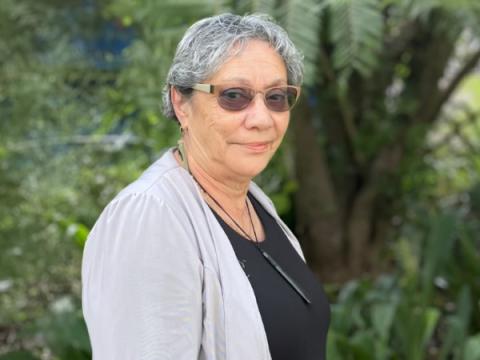
There are about 74,000 registered archaeological sites in the country and most are of cultural significance to Māori. A NPM research project will improve the way archaeological information is being characterised and will likely have implications for all hapū and iwi in relation to their significant sites, according to Professor Annemarie Gillies (Ngāti Kahungunu, Ngāti Awa, Te Arawa).
These significant sites include middens, burial sites, maara kai, terraces and battle grounds. The sites are registered on Archsite, a website operated by the New Zealand Archaeological Association Incorporated, Heritage New Zealand and the Department of Conservation. Many of the sites have storied histories that link them to iwi and hapū, but those connections are largely invisible in the platform. This oversight is a situation Annemarie and her research team wanted to remedy.
Annemarie is working alongside Ngā Hapū o Waimārama to create a more culturally appropriate labelling system for Archsite. Their aim is to ensure the database reflects and acknowledges mātauranga, tikanga and hapū kōrero rather than relying solely on generic archaeological information.
Annemarie’s irāmutu - Ana Te Whaiti, Airini Gillies, and Ejay Gillies - were recruited by Ngā Hapū o Waimārama Māori Committee to work alongside their aunt. After many months of research, meetings and wānanga with the hapū, the team created a set of digital tags that can embed Māori provenance, cultural protocols and permissions into the Archsite platform.
The team are working to have these changes integrated into the platform in the near future. This change will enable archaeologists to be more knowledgeable about the whenua and its history, as well as giving them information pointing to which hapū they need to approach for further access and guidance about archaeological significant areas.
“This research was about reclaiming our cultural narratives, protecting our data sovereignty and getting Māori values into national heritage systems. This is a first for the country - no one has ever done this in the archaeological context,” says Annemarie. This work has been done as a result of the Local Contexts Traditional Knowledge Labels system developed for Indigenous communities to communicate specific rules and protocols for the use and sharing of traditional knowledge and sharing of biocultural data.
A significant outcome of the project was the development of a workflow model that allows for scaling beyond Waimārama to other hapū and iwi. Annemarie is now working with Archsite to allow greater database access for other iwi and hapū who may want to do similar work for their own significant sites.
Given climate change and flooding in some parts of the country, she believes the time is right for Māori to take control of the archaeological information and hapū mātauranga regarding their whenua. “Māori aspirations to record their local histories associated with people and places has become even more urgent especially as the landscapes change.”
Because the project has been led by the hapū, one of the many positive qualities of the project has been the capacity building which it developed for the coming generations. “Developing skills and cultivating a greater connection to my whenua has given me more confidence to be involved in hapū and iwi matters. Because of this project I am keen to be more involved in decision making and contribute more to our people, marae and kura,” says Airini Gillies.
The team is hoping that their project will also strengthen relationships with archaeologists. “It has established boundaries for how archaeologists need to engage with hapū around culturally significant sites. We are open for collaboration and the building of relationships with archaeologists, so that we both benefit, and it is no longer a one-way street, with no benefit back to the hapū,” says Ana Te Whaiti.